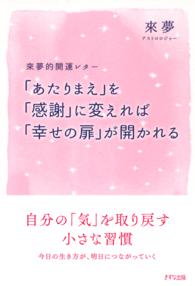- ホーム
- > 洋書
- > 英文書
- > Religion / Ethics
Full Description
The Dao of Translation sets up an East-West dialogue on the nature of language and translation, and specifically on the "unknown forces" that shape the act of translation. To that end it mobilizes two radically different readings of the Daodejing (formerly romanized as the Tao Te Ching): the traditional "mystical" reading according to which the Dao is a mysterious force that cannot be known, and a more recent reading put forward by Sinologists Roger T. Ames and David L. Hall, to the effect that the Dao is simply the way things happen. Key to Ames and Hall's reading is that what makes the Dao seem both powerful and mysterious is that it channels habit into action-or what the author calls social ecologies, or icoses. The author puts Daoism (and ancient Confucianism) into dialogue with nineteenth-century Western theorists of the sign, Charles Sanders Peirce and Ferdinand de Saussure (and their followers), in order to develop an "icotic" understanding of the tensions between habit and surprise in the activity of translating. The Dao of Translation will interest linguists and translation scholars. This book will also engage researchers of ancient Chinese philosophy and provide Western scholars with a thought-provoking cross-examination of Eastern and Western perspectives.
Contents
1. Laozi's Unspeakable Dao 2. The Dao of AbductionPeirce on Translation 2.1 Peirce and his Followers among Semiotic Translation Scholars 2.2 Hartama-Heinonen vs. Robinson 2.3 Exclusive Abduction 2.3.1 Translation as wuwei 2.3.2 + Reasoning 2.3.3 Foreclosing on Secondness and Thirdness 2.4 Guessing as Divining: Peirce on the Mystery 3. The Dao of Empathy: Mengzi's Social Ecologies of Feeling 3.1 On Reading with Empathy 3.2 Mengzi's Ecological Dao 3.3 Habit in Laozi 3.4 Mengzi on Inclinations and Disposition as Habit 3.5 Mengzi on li 3.6 Mengzi on ren: Translation as Transfeeling 3.7 The Chinese Roots of Romantic/Idealist Thought 3.8 Conclusion: "Chinese" Peirce and Saussure? 4. The Dao of Habit: Peirce (and Hartama-Heinonen) on the Tensions between Habit and Surprise 4.1 Peirce on Habit 4.2 Hartama-Heinonen on Habit 4.3 Creativity in the Zhongyong 4.4 Conclusion 5. The Dao of the "Potential for Rules": Saussure on the Structuring Force in/of Language 5.1 Linguistic Entities Have No Objective Existence 5.2 Linguitic Entities are Human Constructs 5.3 Confusions Between the Language System and its Evolution 5.4 The Chaos of the "Potential for Rules" 5.5 Linguistic Entities and Social Values 5.6 Language is Social 5.7 The Intergenerational Transmission of a Preconscious Intensity of Experiential Thought 5.8 A Somatics of Language 5.9 Linguistic Habits and Socioaffective Ecologies 5.10 Translation as Dao 6. The Dao of Habitus 1: Bourdieu (and Damasio) on Body Automatisms 6.1 Socio-ecological Stabilizations of Words 6.2 Habit 6.3 The Collective Organization of Habit 6.4 Habitus 6.5 The "Habitual" Openness of the Social Field 6.6 Somatic Markers 1: Habitus Minus Self 6.7 Somatic Markers 2: Reason Minus Habitus 6.8 Somatic Markers 3: Habitus as a Preparatory Component of Reason 6.9 The Habitus and the Field 6.10 The Affective Transmission of Habitus 7. The Dao of Habitus 2: Simeoni on the Submissive Translator 7.1 Precipitation and Propensity 7.2 Somatic Habituses 7.3 Who is Suited to be a Translator? 7.4 The Submissive Translator 8. Conclusion: D(a)oing Translation
-

- 電子書籍
- comic Berry's 極上パイロ…
-
- 洋書
- Knock Knock
-

- 電子書籍
- 羽林、乱世を翔る~異伝 淡海乃海~ 第…
-

- 電子書籍
- 三級海技士(機関)800題 問題と解答…
-

- 電子書籍
- 來夢的開運レター 「あたりまえ」を「感…




